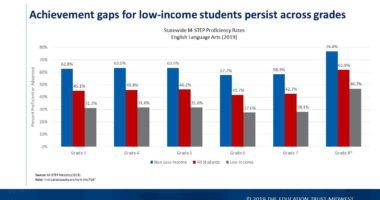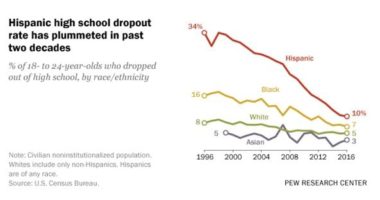Low performance and large gaps in student learning should prompt action at every level
ROYAL OAK, Mich. (Aug. 29, 2019) – The release of new data on student learning in Michigan highlights the need for prompt action to improve learning for all students, with a particular focus on historically underserved student groups. Despite low performance across all student groups, wide gaps persist between students of color and their White peers as well as between students from low-income families and their higher income peers. This comes from just-released data on performance at the end of the 2018-19 school year.
Comparisons with prior year achievement should not be made for eighth grade, as Michigan changed assessments last school year.
“Michigan’s continued low performance on key measures of student learning should trouble us all,” said Brian Gutman, director of external relations at the nonpartisan research and advocacy organization, The Education Trust-Midwest. “But more importantly, it should be a call to action at every level. This means equitable investment in evidence-based practice, improved classroom instruction, and more effective collaboration between schools, parents and communities.”
Of particular focus and concern is Michigan’s stagnant early literacy scores. That is because beginning this school year, students who are reading more than one grade-level behind may be retained, under Michigan’s Read By Grade Three law, Public Act 306 of 2016.
Although Michigan has not yet published data on how many students would have been impacted if the retention requirement had been in effect last school year, Michigan’s third-grade reading scores remain a cause for concern:
- Only 45.1 percent of all third-grade students were grade-level proficient last school year. This is despite well over $100 million in state investment in early literacy supports, since these students entered kindergarten.
- Students of color, students from low-income families and students with disabilities continue to need much greater support. Just one-in-five African American students and about one third of Latino students were grade-level proficient.
- Similarly, only one-in-five students with disabilities and 31.3 percent of low-income students were grade-level proficient.
“While the recent focus on the potential impact of Michigan’s coming retention requirement is understandable, it misses a broader point,” added Gutman. “Nearly 55 percent of the entering fourth-grade class this school year is not reading at grade level. And right now, Michigan largely lacks the resources and supports to address the needs of these students.”
A February 2019 poll by EPIC-MRA and The Education Trust-Midwest found that nearly 70 percent of Michigan parents had little or no familiarity with the third-grade reading law. To help address this awareness gap and support students in local districts, The Education Trust-Midwest and Detroit Parent Network are collaborating on parent toolkits and trainings, so that parents can be better equipped to support the needs of their child.
“Michigan’s low performance and significant inequities are seen not just in early literacy, but across every grade and subject,” said Mary Grech, the lead analyst of The Education Trust-Midwest’s analysis of 2018-19 M-STEP data. “These data make clear that gaps in learning outcomes are a symptom, not a cause. To improve outcomes for Michigan’s most struggling students and communities, we need equitable resources and evidence-based practices supporting the needs of our most underserved students.”
A May 2019 report by The Education Trust-Midwest identified that Michigan has one of the least equitable funding formulas in the nation, that our educators lack access to a range of evidence-based professional supports, and that low-income students and students of color are more likely to have inexperienced teachers than students attending schools with higher-income students.
Other results from the spring 2019 M-STEP include:
- Wide achievement gaps continue to persist across tested grades and subject areas.
- In every tested grade in English language arts, the statewide proficiency rate for White students was at least 29 percent higher than for African American students and at least 17 percent higher than for Latino students.
- In math, the statewide proficiency rate for higher income students was at least 30 percent higher than for low-income students, in every tested grade.
- Low proficiency rates in key subject areas, including math, raise concerns. Less than half of Michigan’s White seventh graders scored proficient in math, and the results are even more devastating for students of color. Only about one quarter of Latino students and about one tenth of African American students were proficient in math in 2019.
- While proficiency rates remain very low in Detroit Public Schools Community District (DPSCD), improvement was seen, particularly in math. Between 2018 and 2019, the percentage of students proficient in third-grade math has increased by 14 percent for Latino students, 5 percent for low-income students and 3.2 percent for African American students, in DPSCD. Notably, all-student improvement in DPSCD outpaced all-student improvement statewide on M-STEP in nine out of ten tested grades and subjects with comparable data, between 2018 and 2019.
“Across our communities, Michigan students deserve better,” added Grech. “That means focusing state resources on the learning needs of students, supporting teachers to better meet the needs of students and making the difficult decisions to actually move Michigan toward becoming a top ten education state.”
# # #


